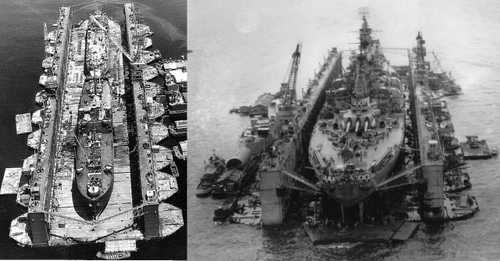
US Navy
Floating dry docks
FBbrummbar
During WWII the US Navy created temporary forward base using Service Stations, they allowed the US Navy to operate across the vast reaches of the Pacific ocean for extended periods of time. These Service Squadrons essentially created a major naval base at a location relatively near the area of operation. With a temporary naval base to refit, repair and resupply, many ships were able to deploy and operate in the western Pacific for a year or more without returning to a major port facility. They provided diesel, ordnance, aviation fuel, food stuffs and all other supplies. Equally important at these places were the portable piers and floating dry docks which allowed many ships damaged by enemy action or Pacific storms to undergo repair without having to travel the thousands of miles back to a major US naval base. Ulithi was as far forward from the US naval base at San Francisco as the San Francisco base was from London, England. To have a fully functional major port in the middle of the Pacific was a significant aid to U.S. Navy operations. The official term for a floating dry dock was: ABSDs, Advance Base Sectional Docks and they were built in sections. The individual sections were small enough to withstand the stress of being towed in heavy seas and were were welded together once they arrived at the advanced base. The docks came in two sizes, with the largest ones built out of ten sections, each 256′ long and 80′ wide and with a lift of 10,000 tons. These were welded together side to side to produce an assembled dock 927′ long and 256′ wide that could lift a warship 827′ long, 133′ wide, and displacing up to 90,000 tons. This was sufficient for any ship in the fleet. The smaller version came in seven sections, each 204′ long and 101′ wide and capable of lifting 8000 tons. When assembled, it could lift a ship 725′ (221m) long , 120′ (37m) wide, and displacing up to 55,000 tons. The sections were given a rough hull form that allowed them to be towed at 6 to 8 knots, with the side walls folded down to reduce wind resistance and lower the center of gravity. They had their own diesel generators and crew quarters. Each assembled dock had two cranes with a lift of 15 tons that ran on rails atop the assembled walls of the dock. A total of 58 ABSD sections were constructed during the war, sufficient for three of the larger docks and four of the smaller docks. The first ABSD was assembled at Noumea in 1943 and a second was being assembled at Espiritu Santo at the end of the year. Total Navy floating dry dock capacity was 108,000 tons by the end of 1942 and 723,000 tons at the end of 1943. FB/Warhistory on line See more photos on : https://www.warhistoryonline.com/military-vehicle-news/massive-floating-dry-docks-of-the-pacific-fleet.html/2
4256 Views
12/17/2015
